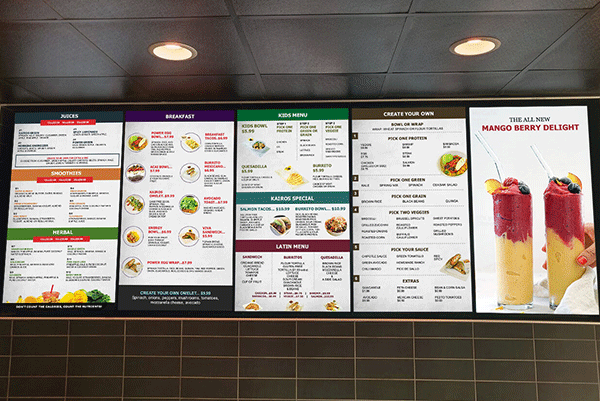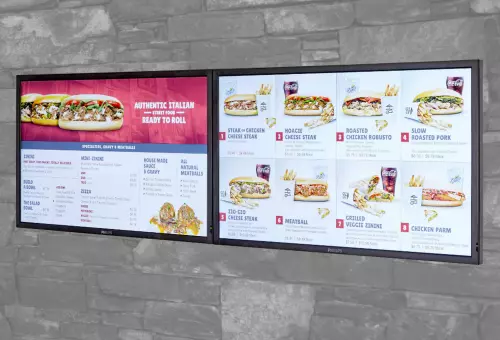
Digital Menu Board
Digital Menu Board In today’s fast-paced world, the restaurant industry is constantly evolving to meet the changing needs and preferences of customers. One such innovation that has transformed the way restaurants operate is the digital menu board. Gone are the days of traditional static menus; digital menu boards have taken center stage.
What Is Digital Menu Board:
Digital Menu Board captivates customers and provides numerous benefits to restaurant owners. In this article, we will explore the power of digital menu boards and how they are revolutionizing the restaurant industry.
Engaging Visual Appeal:
Digital menu boards offer a dynamic and visually appealing way to showcase menu items. With vibrant colors, high-definition images, and eye-catching animations, these boards can grab the attention of customers and entice them to explore the offerings. By presenting menu items in an appealing manner, digital menu boards create a sense of excitement and anticipation, enhancing the overall dining experience for customers.
Flexibility and Easy Updates:
One of the significant advantages of digital menu boards is their flexibility and ease of updates. Unlike traditional static menus that require printing and replacement whenever there are changes, digital menu boards allow instant modifications. Whether it’s updating prices, adding new items, or making seasonal changes, restaurant owners can make adjustments effortlessly through a centralized control system. This ensures that customers are always presented with accurate and up-to-date information, eliminating any confusion or disappointment.
Promotion and Upselling Opportunities:
Digital menu boards serve as excellent platforms for promoting specials, limited-time offers, and upselling. By utilizing the digital format, restaurant owners can strategically highlight specific items, introduce combo meals, or showcase add-ons, enticing customers to try new offerings or upgrade their orders. The ability to display visually appealing images and videos enhances the effectiveness of promotions, increasing the likelihood of customer engagement and boosting sales.
Enhanced Customer Experience:
Digital menu boards contribute to an enhanced customer experience in several ways. Firstly, the visually appealing displays create an immersive and modern ambiance, elevating the overall dining environment. Secondly, the ability to display nutritional information and ingredient details helps customers make informed choices, catering to various dietary preferences and restrictions. Moreover, digital menu boards can incorporate interactive features such as touchscreen capabilities, allowing customers to customize their orders or explore additional information about the menu items. These interactive elements provide a personalized experience and empower customers to tailor their meals according to their preferences.
Efficiency and Cost Savings:
Implementing digital menu boards can streamline operations and lead to significant cost savings for restaurant owners. Firstly, the centralized control system enables simultaneous updates across multiple locations, eliminating the need for manual updates at each site. This saves time and resources for staff, allowing them to focus on other critical tasks. Secondly, by reducing the reliance on printed materials, restaurant owners can cut down on printing costs and reduce environmental waste. Digital menu boards offer a sustainable alternative that aligns with the increasing demand for eco-friendly practices.
Data Analytics and Insights:
Digital menu boards provide valuable data analytics and insights that can help restaurant owners make informed decisions. By tracking customer interactions, engagement levels, and ordering patterns, owners can gather valuable information about customer preferences and behaviors. This data can be utilized to refine menu offerings, optimize pricing strategies, and tailor marketing campaigns. With access to actionable insights, restaurant owners can make data-driven decisions to improve operational efficiency, increase customer satisfaction, and drive profitability.
Conclusion:
Digital menu boards have emerged as a powerful tool in the restaurant industry, revolutionizing the way menus are presented and enhancing the overall dining experience. With their engaging visual appeal, flexibility, and easy updates, these digital displays captivate customers and provide ample opportunities for promotion and upselling. Moreover, digital menu boards contribute to a more efficient and cost-effective operation while offering valuable data analytics and insights. As technology continues to advance, the adoption of digital menu boards is likely to increase, shaping.
Digital Menu Board How Its Works?
Digital menu boards are designed to provide a dynamic and interactive way of presenting menu items to customers. They consist of display screens, media players, and content management software that work together to create a captivating and seamless experience. Let’s explore how digital menu boards work:
- Hardware Setup: Digital menu boards require a hardware setup that includes display screens or monitors, media players, and potentially additional equipment such as touchscreens or sensors. The screens can vary in size and orientation depending on the restaurant’s requirements and the desired placement.
- Media Players: Media players are small devices that connect to the display screens and deliver the content. They are responsible for processing and displaying the images, videos, animations, and other multimedia elements that make up the digital menu board content. Media players can be standalone devices or integrated directly into the display screens.
- Content Creation and Management: The content displayed on the digital menu board is created and managed using content management software. This software allows restaurant owners or managers to design, customize, and schedule the content to be shown on the screens. It provides an interface where users can upload images, videos, pricing information, descriptions, and other relevant data.
- Network Connectivity: To ensure real-time updates and synchronization across multiple screens, digital menu boards typically require an internet connection. This connection allows the media players to connect to the content management software and receive updates and new content remotely. It also enables centralized control and management of the digital menu boards from a single location.

- Display and Content Rotation: The content management software enables the scheduling and rotation of the content displayed on the digital menu board. Restaurant owners can program different layouts, themes, and promotions to appear at specific times of the day or during different periods, such as breakfast, lunch, or dinner. This flexibility allows for easy customization and adaptation to changing menu items or promotions.
- Interactivity (Optional): Some digital menu boards incorporate interactive features, such as touchscreens or sensors, to engage customers further. Touchscreens enable customers to browse through the menu, customize their orders, or access additional information about specific items. Sensors can be used to trigger content changes based on customer proximity or other predefined actions.
- Updates and Maintenance: Digital menu boards offer the advantage of instant updates and changes. Restaurant owners can remotely update prices, add new items, modify descriptions, or change promotions with a few clicks, ensuring that the displayed content is always accurate and up-to-date. Regular maintenance, including software updates and hardware checks, is necessary to ensure optimal performance and longevity of the digital menu boards.
Final Words:
Digital menu boards provide a dynamic and flexible platform for restaurants to showcase their offerings and engage customers in a visually appealing and interactive manner. They offer numerous benefits, including easy content updates, promotion opportunities, enhanced customer experience, and valuable data analytics. As technology continues to advance, digital menu boards are likely to become even more sophisticated, incorporating advanced features to further improve the customer dining experience.
